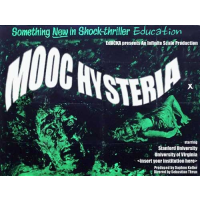University of California’s Ambitious Online Class Project Ambushed by Free Stuff

An innovative plan by the University of California to offer online courses at relatively modest prices to people outside the UC system has run into a formidable obstacle—free stuff available from great schools like Harvard and Stanford.
Two years ago, when UC Online was conceived, the plan was to eventually sign up 7,000 non-UC students paying between $1,400 and $2,400 each, beginning with 3,000 students in 2012. The program, which went beyond the online offerings already available at UC, enrolled one high school girl for a 4-credit precalculus class at UC Irvine, according to the San Francisco Chronicle.
UC was done in by MOOCs, Massive Open Online Courses that became all the rage just about the time UC Online was rolled out. MOOCs are online classes, usually free and credit-less, that present educational material in a non-traditional format. Instead of the not uncommon online class that is basically a camera pointed at a lecturer, MOOCs offer highly-interactive, entertaining presentations built around mini-lectures. Group interactivity through social networking is encouraged.
The New York Times called 2012 “The Year of the MOOC.”
Harvard and the Massachusetts Institute of Technology signed up 370,000 students last fall through a partnership with the non-profit MOOC edX. More than 1.7 million students have signed up for classes with Coursera, and Udacity, a MOOC provider out of Stanford, debuted with an “Introduction to Artificial Intelligence” and drew 160,000 students in more than 190 countries. Coursera works with more than 30 big-name schools, including Princeton, Columbia and Duke.
In contrast, UC Online has struggled to get going. The Chronicle of Higher Education reported in April 2011 that a pilot project would offer 20 classes to UC students by January 2012. Only six were offered in the spring and eight the following fall. The university’s offerings to outside students fell flat. UC Online has spent most of its initial $6.9 million startup loan from UC on marketing its classes.
One of the big challenges facing MOOCs is the development of a business model that makes money. Right now, the movement is fueled by venture capital, but that can’t last forever. There is talk of charging modest fees in exchange for student certification. But right now, only 10-20% of students who enroll in a class stay to the end. Others have suggested that MOOCs might act as headhunters for companies, paid for hooking up employers with promising students.
It’s evolving. As is UC Online. Governor Jerry Brown, who sits on the UC Regents board, is skeptical of the university’s effort and, according to the San Francisco Chronicle, exchanged smack talk with UC Berkeley Chancellor Robert Birgeneau at their November meeting. Brown told Birgeneau, “There's stuff going on in Silicon Valley that will leave you in the dust,” to which the chancellor replied, “We’re ahead of them. . . . There’s a lot happening, governor.”
–Ken Broder
To Learn More:
UC Online Courses Fail to Lure Outsiders (by Nanette Asimov, San Francisco Chronicle)
UC Online Strives to Compete in an Era of Free Courses (by Alisha Azevedo, The Chronicle of Higher Education)
The Year of the MOOC (by Laura Pappano, New York Times)
How Will MOOCs Make Money? (by Steve Klowich, Inside Higher Ed)
The Online Pecking Order (by Steve Klowich, Inside Higher Ed)
- Top Stories
- Controversies
- Where is the Money Going?
- California and the Nation
- Appointments and Resignations
- Unusual News
- Latest News
- California Forbids U.S. Immigration Agents from Pretending to be Police
- California Lawmakers Urged to Strip “Self-Dealing” Tax Board of Its Duties
- Big Oil’s Grip on California
- Santa Cruz Police See Homeland Security Betrayal in Use of Gang Roundup as Cover for Immigration Raid
- Oil Companies Face Deadline to Stop Polluting California Groundwater





